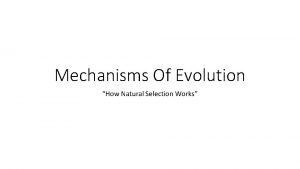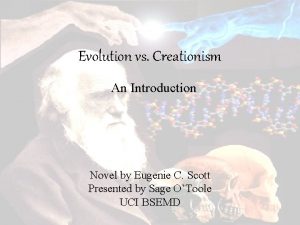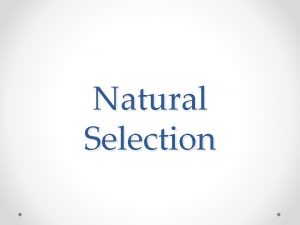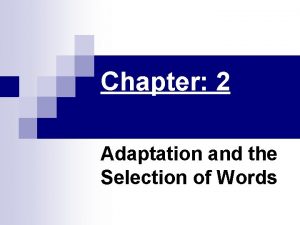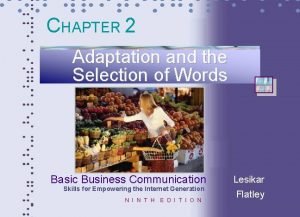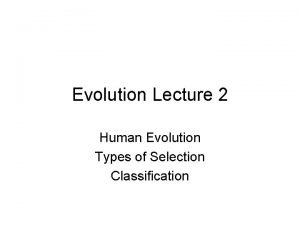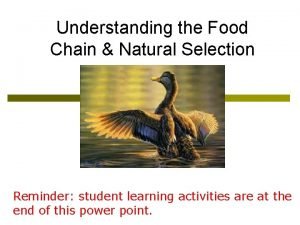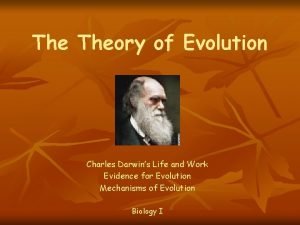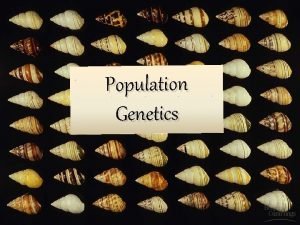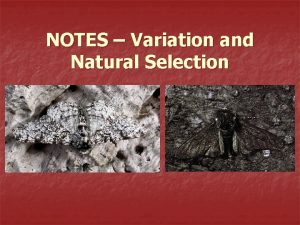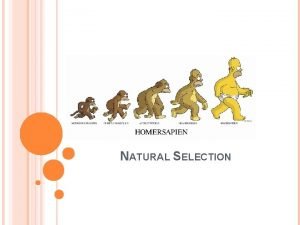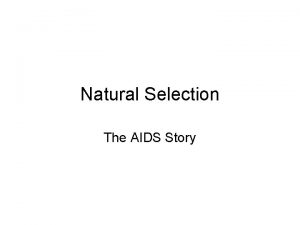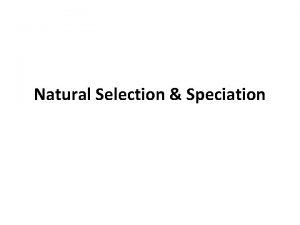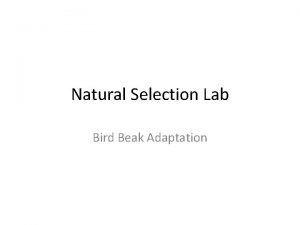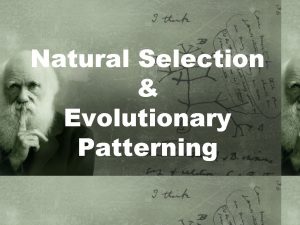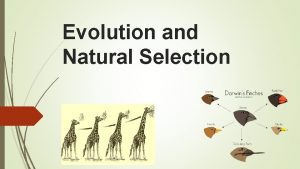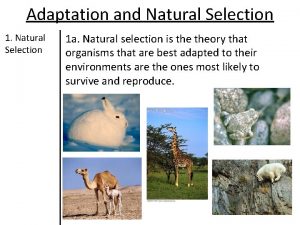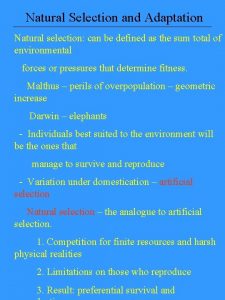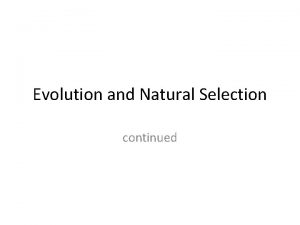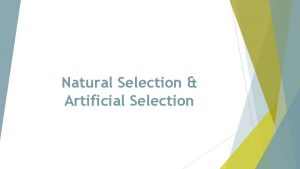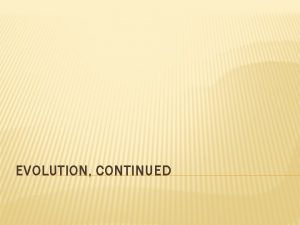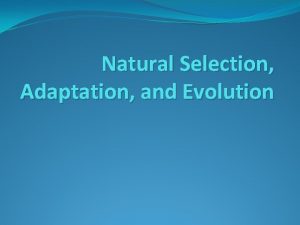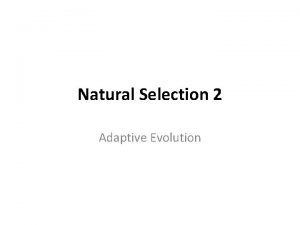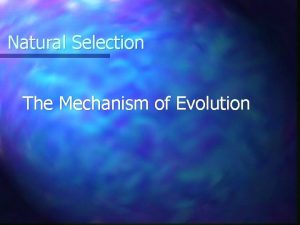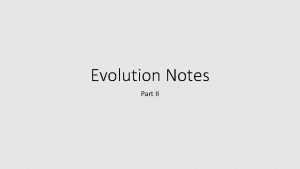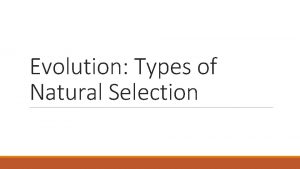New Unit EVOLUTION Evolution Continued Adaptation Natural Selection


























- Slides: 26

New Unit: EVOLUTION

Evolution Continued: Adaptation Natural Selection & Artificial Selection

Natural Selection as the main mechanism for Evolution: Three key sets of observations to explain this: 1. The struggle for existence 2. Natural variations among members of a species 3. The environment’s role in evolution

1. The struggle for Existence Darwin noticed that all species tend to produce excessive numbers of offspring But, resources are limited So, the production of more individuals than the environment can support leads to a struggle for existence among the individuals of a population

2. Natural Variation There is variation among the individuals of a population and the variation takes place over a long period of time Variation refer to the differences among members of the same species (eg. look around in your classroom and notice differences in skin tone, hair colour, facial features) Much of this variation is heritable

Darwin noticed that plants and animals in South America were quite distinct from species in Europe and Africa. Related animal species that occupied different habitats within a local environment had different features. This was most obvious on islands (eg. Galapagos Island the finches)

3. The role of the Environment There are variations among members of a species and the environment selected for those variations that were best suited for that environment. Contrary to Lamarck’s belief: Darwin would say that in a population of giraffes, some were born with short necks and some with long necks but the environment favoured the long neck giraffes so they survived and reproduced passing along their characteristics to the next generation


2 example cases for evidence of natural selection: Finch Beaks Video Antibiotic Resistance


DARWIN’S FINCHES(pg 366): the common ancestor initially gave rise to several groups of finches. As time passed, populations within different groups became geographically and reproductively isolated from one another




In the Galapagos Islands, finches evolved a variety of beak types adapted for cracking open different kinds of seeds. Changes in weather patterns have been shown to change the kinds of seeds available—for example during drought, tough seeds that are difficult to crack are more abundant than soft seeds. Finches with large beaks adapted for eating these hard seeds are more likely to survive and reproduce than other finches. These finches become more abundant compared to those with small beaks.

Galapagos formed from volcanoes Different islands have different environments Each island has its own species

ANTIBIOTIC RESISTANCE: Antibiotics Introduced The more resistant bacteria (containing resistant genes against the antibiotic) survive into the next generation and so on…)

How do bacteria become resistant?

HOW DO BACTERIA BECOME RESISTANT TO ANTIBIOTICS? Bacteria develop random mutations as they reproduce via successive generation. These random mutations could create a favourable gene (beneficial mutation). Let’s say it codes for a protein that protects the bacteria from antibiotics. In particular environments (eg. Hospitals where antibiotics are often misused); bacteria with the beneficial mutation is favourably selected and is more fit to survive the next generation… Since bacteria reproduce quick, more antibiotic resistant bacteria thrive. Also, bacteria that contain the antibiotic resistant gene can share this information with ‘weaker’ bacteria through conjugation.

CONJUGATION


BINARY FISSION CONJUGATION Bacteria can reproduce by conjugation, or asexually by binary fission.

Some can reproduce every 20 minutes (one bacteria could be an ancestor to one million bacteria in six hours) BINARY FISSION DIVISION COMPLETE

In Class Read Activity 7. 2 on page 302 TUBERCULOSIS: Adapting Populations of Bacteria Complete and answer questions 1 -4

Natural Selection vs Artificial Selection Next Powerpoint

Other Important "Guys" 1. Read Section 8. 1 and make notes on the following people: ◦ Buffon ◦ Cuvier (catastrophism) ◦ Lyell (uniformitarianism) ◦ Lamarck (inheritance of acquired characteristics) ◦ Wallace (survival of the fittest) 2. H/W: p. 331 #1, 4 -6, 11, 12, 14
 Artificial selection vs natural selection
Artificial selection vs natural selection Natural selection vs artificial selection
Natural selection vs artificial selection Difference between continuous and discontinuous variation
Difference between continuous and discontinuous variation Disruptive selextion
Disruptive selextion Natural selection vs artificial selection
Natural selection vs artificial selection 3 types of natural selection
3 types of natural selection Evolutionary mechanisms
Evolutionary mechanisms Natural selection vs evolution
Natural selection vs evolution Natural selection biology definition
Natural selection biology definition Adaptation and selection of words
Adaptation and selection of words Adaptation and selection of words
Adaptation and selection of words Balancing selection vs stabilizing selection
Balancing selection vs stabilizing selection K selection r selection
K selection r selection Logistic model of population growth
Logistic model of population growth Two way selection and multiway selection in c
Two way selection and multiway selection in c Multiway selection
Multiway selection Mass selection and pure line selection
Mass selection and pure line selection Types of natural selection
Types of natural selection Requirements for natural selection
Requirements for natural selection 4 principles of natural selection
4 principles of natural selection Stabilizing selection human birth weight
Stabilizing selection human birth weight Requirements for natural selection
Requirements for natural selection Types of natural selection
Types of natural selection How big are jaguars teeth
How big are jaguars teeth What basketball player has aids
What basketball player has aids 3 types of natural selection
3 types of natural selection Bird beak adaptation lab
Bird beak adaptation lab






